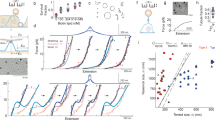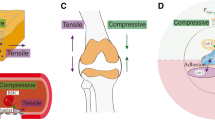Abstract
The ligand–receptor complexes in the cell–cell and cell–ECM interfaces mediate the mechanical coupling of cells to their microenvironment and transduce downstream signals to modulate cell functions. In this chapter I describe a microfabrication strategy to prepare a substrate of spatially segregated supported lipid bilayers and ECM components on which cells can form juxtacrine receptor signaling complexes and integrin adhesions simultaneously. This platform is specifically applicable for microscopically monitoring the signal transduction of each receptor, as well as the modulatory effects of receptor signaling on integrin adhesions and cell behaviors.
Access this chapter
Tax calculation will be finalised at checkout
Purchases are for personal use only
Similar content being viewed by others
References
Wang XF, Ha T (2013) Defining single molecular forces required to activate integrin and notch signaling. Science 340(6135):991–994
Basu R, Whitlock BM, Husson J, Le Floc’h A, Jin W, Oyler-Yaniv A, Dotiwala F, Giannone G, Hivroz C, Biais N et al (2016) Cytotoxic T cells use mechanical force to potentiate target cell killing. Cell 165(1):100–110
Natkanski E, Lee W-Y, Mistry B, Casal A, Molloy JE, Tolar P (2013) B cells use mechanical energy to discriminate antigen affinities. Science 340(6140):1587–1590
Casaletto JB, McClatchey AI (2012) Spatial regulation of receptor tyrosine kinases in development and cancer. Nat Rev Cancer 12(6):386–399
Salaita K, Nair PM, Petit RS, Neve RM, Das D, Gray JW, Groves JT (2010) Restriction of receptor movement alters cellular response: physical force sensing by EphA2. Science 327(5971):1380–1385
Parri M, Buricchi F, Giannoni E, Grimaldi G, Mello T, Raugei G, Ramponi G, Chiarugi P (2007) EphrinA1 activates a Src/focal adhesion kinase-mediated motility response leading to rho-dependent actino/myosin contractility. J Biol Chem 282(27):19619–19628
Lisabeth EM, Falivelli G, Pasquale EB (2013) Eph receptor signaling and Ephrins. Cold Spring Harb Perspect Biol 5(9):a009159
Chen Z, Oh D, Biswas KH, Yu C-H, Zaidel-Bar R, Groves JT (2018) Spatially modulated ephrinA1:EphA2 signaling increases local contractility and global focal adhesion dynamics to promote cell motility. Proc Natl Acad Sci 115(25):E5696–E5705
Chen Z, Oh D, Biswas KH, Zaidel-Bar R, Groves JT (2021) Probing the effect of clustering on EphA2 receptor signaling efficiency by subcellular control of ligand-receptor mobility. elife 10:20210820
Yu C-h, Rafiq NBM, Cao F, Zhou Y, Krishnasamy A, Biswas KH, Ravasio A, Chen Z, Wang Y-H, Kawauchi K et al (2015) Integrin-beta3 clusters recruit clathrin-mediated endocytic machinery in the absence of traction force. Nat Commun 6:8672
Alieva NO, Efremov AK, Hu S, Oh D, Chen Z, Natarajan M, Ong HT, Jégou A, Romet-Lemonne G, Groves JT et al (2019) Myosin IIA and formin dependent mechanosensitivity of filopodia adhesion. Nat Commun 10(1):3593
Wong JJ, Chen Z, Chung JK, Groves JT, Jardetzky TS (2021) EphrinB2 clustering by Nipah virus G is required to activate and trap F intermediates at supported lipid bilayer–cell interfaces. Sci Adv 7(5):eabe1235
Acknowledgments
Z.C. was supported by Shanghai Pujiang Program (20PJ1400800) and Shanghai Municipal Science and Technology Major Project (2019SHZDZX02).
Author information
Authors and Affiliations
Corresponding author
Editor information
Editors and Affiliations
Rights and permissions
Copyright information
© 2023 The Author(s), under exclusive license to Springer Science+Business Media, LLC, part of Springer Nature
About this protocol
Cite this protocol
Chen, Z. (2023). Using Micropatterned Supported Lipid Bilayers to Probe the Mechanosensitivity of Signaling Receptors. In: Zaidel-Bar, R. (eds) Mechanobiology. Methods in Molecular Biology, vol 2600. Humana, New York, NY. https://doi.org/10.1007/978-1-0716-2851-5_18
Download citation
DOI: https://doi.org/10.1007/978-1-0716-2851-5_18
Published:
Publisher Name: Humana, New York, NY
Print ISBN: 978-1-0716-2850-8
Online ISBN: 978-1-0716-2851-5
eBook Packages: Springer Protocols




